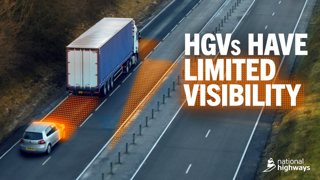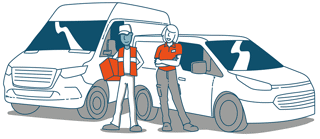Employers are being urged by National Highways to pay as much attention to incidents of bad driving by company drivers as they do to poor behaviour in the office.
Mark Cartwright, head of commercial vehicle incident prevention at National Highways, has highlighted the importance of managing risk on the road as effectively as within business premises, as it significantly reduces casualties on the road network.
He is encouraging fleet managers and drivers to share best practices and engage with employees, emphasising the need to recognise the risks they face.
Speaking on a PDT Fleet Training podcast, he said: “One of the things that terrify and fascinates me in probably equal amounts is the number of health and safety organisations I've come across with robust systems and talented managers and directors that don't get that their responsibilities extend out onto the road.
“You wouldn't allow or turn a blind eye to bad behaviour within an office space or production facility, so why aren't we having the same rigour with company drivers or people driving for work?”
Network Highways’ ambition is to achieve zero casualties on the strategic road network by 2050.
Last week, National Highways encouraged fleet operators to join its free trial of Ping, its driver behaviour initiative that uses cameras on the road network to flag dangerous driving.
Ping uses various sensors and cameras on the strategic road network (SRN) to “ping” alerts to fleet operators to notify them of dangerous driving behaviours.
This includes speeding, close following, weigh in-motion sites, mobile phone and red-X offences.
Cartwright urged business leaders to consider the impact of their employees' driving behaviours. "A great majority of vehicles on our network are for work purposes,” he said. “Be a demanding client. If you want to come and work for us, show us you know how to keep yourself and everyone on our network safe.”
New campaign launched to monitor bad HGV drivers

In a separate initiative, road safety experts at Snooper are campaigning to have all HGVs in the UK fitted with stickers for other road users to go online and rate their driving.
The campaign aims to help protect both HGV drivers as much as other road users by reducing the time lorries spend in the far right-hand lane.
It’s illegal for all Heavy Goods Vehicles weighing 7.5 tonnes or more to use the right-hand lane of a motorway when there are three or more lanes.
Driving in the third lane could see HGV drivers landed with a hefty £2500 fine and three penalty points on their licence, or even a driving disqualification.
The latest data shows that there were 654 reported road fatalities in collisions involving HGVs between 2019-2021.
The ‘How’s My Driving’ campaign will allow road users to report any dangerous driving to the HGV’s owner or business, as well as to the DVLA.
With lorry drivers under closer monitoring, less incidents and collisions are likely to occur, as more HGV users will understand the importance of not using the right hand lane, says Snooper.
Gary Digva, from Snooper, explained: “We want to make it mandatory for all HGVs to have ‘How’s My Driving’ stickers on the back of the vehicles to encourage motorists to watch their driving and to stick to the rules of the Highway Code.
“Obviously it is a small minority of HGV drivers who are unlawfully using the right-hand lane to bypass other traffic, but there is a reason why this law is in place.
“Making it illegal to let HGVs into the third lane protects all other road users from the significantly larger and heavier vehicles on the roads, especially along motorways whilst travelling at high speeds.
“Especially in extreme weather conditions, it is even more vital for lorry drivers to use the first two lanes only, as strong winds could blow HGVs off course and into other vehicles.
“With other road users being able to report dangerous driving to the HGVs operator or company, drivers risk having contracts terminated, penalties charged and points added to their licence - and even disqualification from driving.”
























Login to comment
Comments
No comments have been made yet.